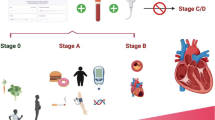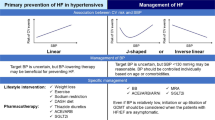Abstract
Purpose
Data are limited regarding the adequacy of risk factor control and adherence to recommended therapies among adults with heart failure (HF). We evaluated the adequacy of risk factor control and adherence to recommended pharmacologic therapies among non-institutionalized US adults with HF.
Methods
We examined data from US adults aged 18 years and older with a self-reported history of HF from the US National Health and Nutrition Examination Survey 2007–2008 and 2009–2010. We estimated the proportions of subjects who reported recommended lifestyle modification and medications and were at target levels of blood pressure, low-density lipoprotein cholesterol (LDL-C), and hemoglobin A1c.
Results
Among 371 subjects with HF in our study, 73.7 % were non-smokers, while only 69.1, 51.9, and 56.2 % were at goal for blood pressure, LDL-C, and hemoglobin A1c (if diabetic), respectively; only 9.0 % were at goal for all measures. The proportions of non-smokers were lower in males (p < 0.01) and lowest in non-Hispanic blacks (p < 0.01). Subjects with less than a high school education (p < 0.05) were least likely to be at recommended blood pressure levels. The proportions exercising moderately, with recommended alcohol and sodium intakes, and with a normal body mass index were 8.3, 41.4, 28.9, and 17.5 %, respectively. 83.3 % of HF patients were taking only one of the recommended four classes of drugs [β-blockers, angiotensin converting enzyme inhibitors/angiotensin receptor blockers (ACEIs/ARBs), diuretics, and digoxin]; only 50.1 % were additionally on a lipid-lowering agent.
Conclusion
We observed a significant gap between adherence and control of HF risk factors and treatment among non-institutionalized US adults.



Similar content being viewed by others
References
Hall MJ, Levant S, DeFrances CJ. Hospitalization for congestive heart failure: United States, 2000–2010. NCHS data brief, no 108. Hyattsville: National Center for Health Statistics; 2012.
Elixhauser A, Steiner C. Readmissions to US hospitals by diagnosis 2010. In: Healthcare cost and utilization project; statistical brief#153. http://www.ahrq.gov/index.html. Accessed June 2013.
Heart Failure Fact Sheet. In: Division of Heart Disease and Stroke Prevention. Centers for Disease Control and Prevention. http://www.cdc.gov/dhdsp/data_statistics/fact_sheets/fs_heart_failure. Accessed June 2013.
Zhao Y, Li J, Xue Q, Gao L, Xu Q, Wu X. Etiology, comorbidity and prognosis of hospitalized patients with congestive heart failure. Crit Care. 2010;14(Suppl 1):P129.
Colucci WS. Overview of the therapy of heart failure due to systolic dysfunction. In: UpToDate. http://www.uptodate.com/contents/overview-of-the-therapy-of-heart-failure-due-to-systolic-dysfunction. Accessed June 2013.
Andreas K, Vasiliki G, Stephen BK, et al. Epidemiology of incident heart failure in a contemporary elderly population. The Health, Aging, and Body Composition Study. Arch Intern Med. 2009;169:708–15.
Udell JA, Ray JG. Primary and secondary prevention of heart failure with statins. Expert Rev Cardiovasc Ther. 2006;4:917–26.
Thompson PD, Buchner D, Piña IL, et al. Exercise and physical activity in the prevention and treatment of atherosclerotic cardiovascular disease: a statement from the Council on Clinical Cardiology (Subcommittee on Exercise, Rehabilitation, and Prevention) and the Council on Nutrition, Physical Activity, and Metabolism (Subcommittee on Physical Activity). Circulation. 2003;107:3109–16.
Kenchaiah S, Evans JC, Levy D, et al. Obesity and the risk of heart failure; the Framingham Study. N Engl J Med. 2002;347:305–13.
Van Tol BA, Huijsmans RJ, Kroon DW, Schothorst M, Kwakkel G. Effects of exercise training on cardiac performance, exercise capacity and quality of life in patients with heart failure: a meta-analysis. Eur J Heart Fail. 2006;8:841–50.
He J, Ogden LG, Bazzano LA, Vupputuri S, Loria C, Whelton PK. Risk factors for congestive heart failure in US men and women NHANES I epidemiologic follow-up study. Arch Intern Med. 2001;161:996–1002.
Wu J, Sin DD. Improved patient outcome with smoking cessation: when is it too late? Int J Chron Obstruct Pulmon Dis. 2011;6:259–67.
Shah AM, Pfeffer MA, Hartley LH, et al. Risk of all-cause mortality, recurrent myocardial infarction, and heart failure hospitalization associated with smoking status following myocardial infarction with left ventricular dysfunction. Am J Cardiol. 2010;106:911–6.
He J, Ogden LG, Bazzano LA, Vupputuri S, Loria C, Whelton PK. Dietary sodium intake and incidence of congestive heart failure in overweight US men and women: first National Health and Nutrition Examination Survey Epidemiologic Follow-up Study. Arch Intern Med. 2002;162:1619–24.
Pritchett AM, Deswal A, Aguilar D, et al. Lifestyle modification with diet and exercise in obese patients with heart failure—a pilot study. J Obes Weight Loss Ther. 2012;2:1–8.
Yancy CW, Jessup M, Bozkurt B, et al. ACCF/AHA Guideline for the management of heart failure: a report of the American College of Cardiology Foundation/American Heart Association Task Force on Practice Guidelines. J Am Coll Cardiol. 2013. http://Content.onlinejacc.org/article.aspx?articleid=1695826. Accessed June 2013.
Lindenfeld J, Albert NM, Boehmer JP, et al. Heart Failure Society of America. Evaluation of patients for ventricular dysfunction and heart failure: HFSA 2010 comprehensive heart failure practice guideline. J Card Fail. 2010;16:e44–56.
Chow MS. Assessing the treatment of congestive heart failure: diuretics, vasodilators, and angiotensin-converting enzyme inhibitors. Pharmacotherapy. 1993;13:82S–7S.
Mario M. Effects of exercise on ejection fraction, arrhythmias, dyspnea, and functional capacity in congestive heart failure patients. URJHS 2008;7. http://www.kon.org/urc/v7/mitkov.html. Accessed June 2013.
Garg R, Yusuf S. Overview of randomized trials of angiotensin-converting enzyme inhibitors on mortality and morbidity in patients with heart failure Collaborative Group on ACE Inhibitor Trials. JAMA. 1995;273:1450–6.
Hart SM. Influence of beta-blockers on mortality in chronic heart failure. Ann Pharmacother. 2000;34:1440–51.
Pitt B, Zannad F, Remme WJ, et al. The effect of spironolactone on morbidity and mortality in patients with severe heart failure: Randomized Aldactone Evaluation Study Investigators. N Engl J Med. 1999;341:709–17.
MacDonald MR, Eurich DT, Majumdar SR, et al. Treatment of type 2 diabetes and outcomes in patients with heart failure: a nested case–control study from the U.K. general practice research database. Diabetes Care. 2010;33:1213–8.
Rahimtoola SH. Digitalis therapy for patients in clinical heart failure. Circulation. 2004;109:2942–6.
National Health and Nutrition Examination Survey 2007–2008 and 2009–2010: laboratory/medical technologist procedural manual (online). http://www.cdc.gov/nchs/currentnhanes.htm. Accessed 2013.
Dickstein K, Cohen-Solal A, Filippatos G, et al. ESC Guidelines for the diagnosis and treatment of acute and chronic heart failure 2008: the Task Force for the Diagnosis and Treatment of Acute and Chronic Heart Failure 2008 of the European Society of Cardiology. Developed in collaboration with the Heart Failure Association of the ESC (HFA) and endorsed by the European Society of Intensive Care Medicine (ESICM). Eur Heart J. 2008;29:2388–442.
Lopert R, Shoemaker JS, Davidoff A, Shaffer T, Abdulhalim AM, Lloyd J, Stuart B. Medication adherence and Medicare expenditure among beneficiaries with heart failure. Am J Manag Care. 2012;18:556–63.
Sueta CA, Massing MW, Chowdhury M, et al. Undertreatment of hyperlipidemia in patients with coronary artery disease and heart failure. J Card Fail. 2003;9:36–41.
West R, Liang L, Fonarow GC, Kociol R, et al. Characterization of heart failure patients with preserved ejection fraction: a comparison between ADHERE-US and ADHERE-International registry. Eur J Heart Fail. 2011;13:945–52.
Abete P, Testa G, Della-Morte D, Gargiulo G, Galizia G, de Santis D, Magliocca A, Basile C, Cacciatore F. Treatment for chronic heart failure in the elderly: current practice and problems. Heart Fail Rev. 2013;18:529–51.
Fabbri G, Gorini M, Maggioni AP, Cacciatore G, Lenarda DA. Italian network on congestive heart failure: ten-year experience. G Ital Cardiol (Rome). 2006;7:689–94.
Vulic D, Lee BT, Dede J, Lopez VA, Wong ND. Extent of control of cardiovascular risk factors and adherence to recommended therapies in US multiethnic adults with coronary heart disease: from a 2005–2006 National Survey. Am J Cardivasc Drugs. 2010;10:109–14.
Anderson C, Deepak BV, Amoateng-Adjepong Y, Zarich S. Benefits of comprehensive inpatient education and discharge planning combined with outpatient support in elderly patients with congestive heart failure. Congest Heart Fail. 2005;11:315–21.
Kociol RD, Peterson ED, Hammill BG, et al. National survey of hospital strategies to reduce heart failure readmissions: findings from the Get With the Guidelines-Heart Failure registry. Circ Heart Fail. 2012;5:680–7.
Mehta RH, Montoye CK, Gallogly M, et al. Improving quality of care for acute myocardial infarction: the Guidelines Applied in Practice (GAP) Initiative. JAMA. 2002;287:1269–76.
Acknowledgments
All data used in this study were collected by the National Center for Health Statistics, Centers for Disease Control and Prevention. The authors thank the investigators, the staff, and the participants of NHANES for their valuable contribution. There was no funding provided for this study or the preparation of this article.
Conflict of interest
None.
Author information
Authors and Affiliations
Corresponding author
Rights and permissions
About this article
Cite this article
Lama Tamang, T.G., Tang, L., Chuang, J. et al. Examining Risk Factor Goal Attainment and Adherence to Treatment Among US Heart Failure Patients: The National Health and Nutrition Examination Survey 2007–2010. Am J Cardiovasc Drugs 14, 41–49 (2014). https://doi.org/10.1007/s40256-013-0046-z
Published:
Issue Date:
DOI: https://doi.org/10.1007/s40256-013-0046-z




